THE NEWHAVEN-DIEPPE CAR FERRY SERVICE
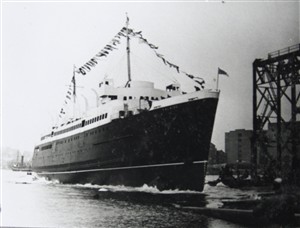
Falaise enters the water, October 1946
Newhaven Museum
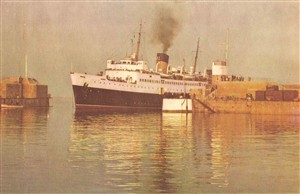
Falaise's maiden arrival at Jersey in 1947
K Le Scelleur
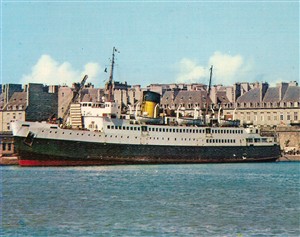
Falaise in the Channel Islands
K Le Scelleur
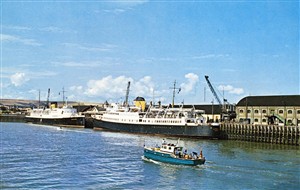
Newhaven before the car ferry service started. Lisieux has just arrived from Dieppe while Arromanches is in the night berth, where the car ferry ramp would soon be built.
John Hills
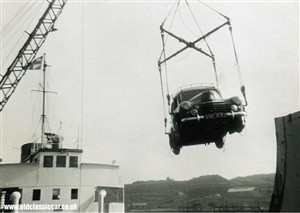
A Vauxhall Velox swings around while being loaded onto the Dieppe screw Brest at Newhaven in the late 1950s
Courtesy of www.oldclassiccar.co.uk
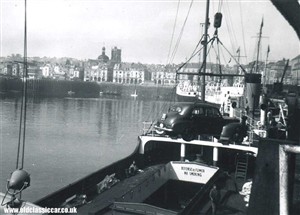
The same car being offloaded at Dieppe a few hours later
Courtesy of www.oldclassiccar.co.uk
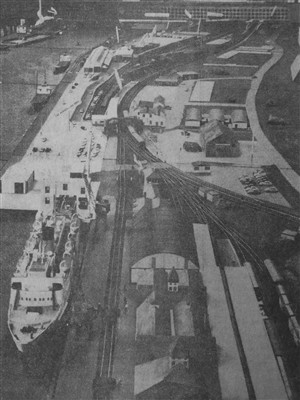
The model of 'Newhaven 1965'
Sussex Express / Newhaven Museum
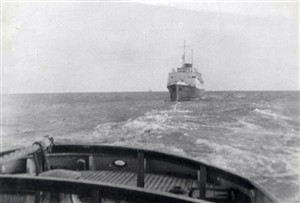
The redundant Londres is towed away by Meeching, December 23rd 1963
Andy Gilbert
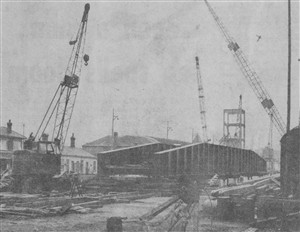
The link span prior to fitting
Sussex Express / Newhaven Museum
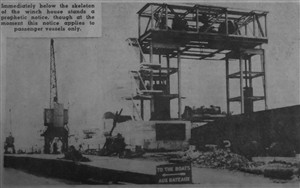
An almost completed ramp. Lisieux is still using the night berth.
Sussex Express / Newhaven Museum
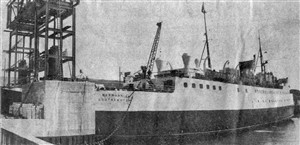
Normannia tries out the ramp for size
Sussex Express / Newhaven Museum
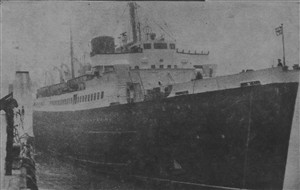
Falaise moors at Newhaven for the very first time
Sussex Express / Newhaven Museum
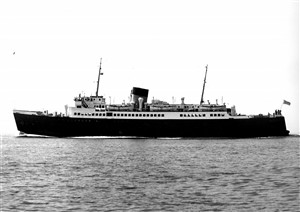
14th May 1964. Falaise on trials off Newhaven
John Hendy
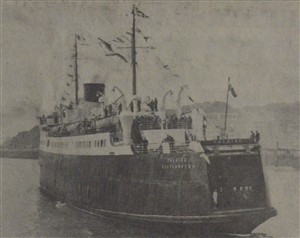
31st May 1964. Falaise sails with VIPs on board
Sussex Express / Newhaven Museum
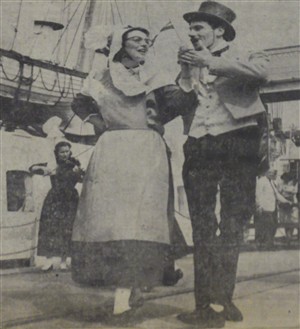
Normandy dancers on the quayside as part of the festivities
Sussex Express / Newhaven Museum
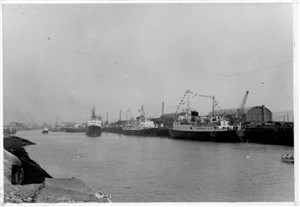
With Meeching in attendance, Falaise leaves the ramp for her VIP trip
Newhaven Museum
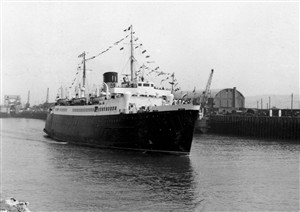
Falaise passes Brighton and heads for the harbour entrance.
Newhaven Museum
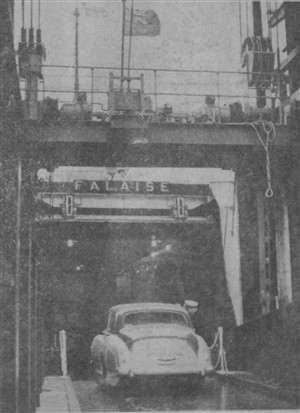
The first paying car, appropriately a Rolls-Royce, goes aboard in 1st June 1964
Newhaven Museum
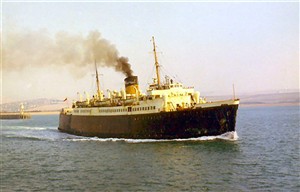
Falaise leaves Newhaven for Dieppe during her first season.
Derek Longly
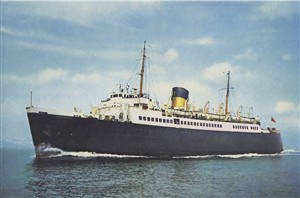
Official postcard of Falaise in her first season colours
Andy Gilbert collection
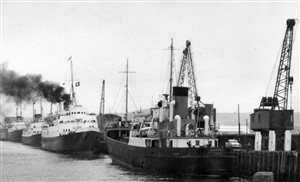
Full house at the East Quay in 1964. Falaise, Arromanches, Brighton (about to sail) and the Dieppe Screw Nantes
Newhaven Museum
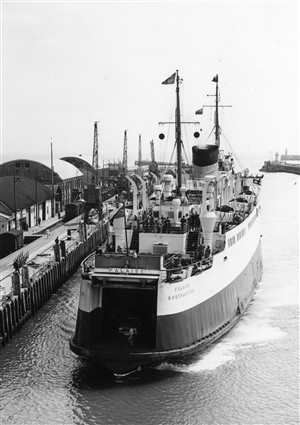
Falaise backs into the ramp, 1966. Note the two black balls hoisted on the after mast, showing that she is going astern.
Jim Ashby collection
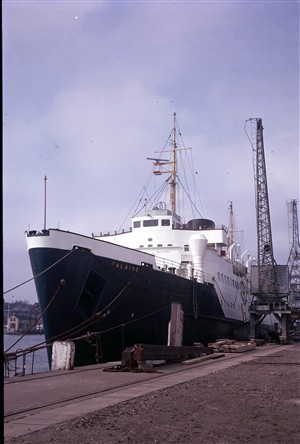
Falaise at the East Quay, post 1965
Laurie Stonehouse
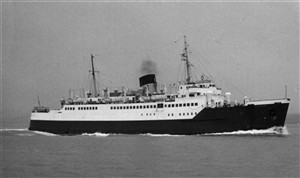
Falaise's final service departure from Newhaven, September 25th 1972
Andy Gilbert collection
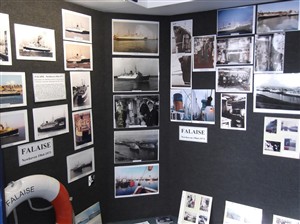
The anniversary exhibit at Newhaven Museum
Andy Gilbert
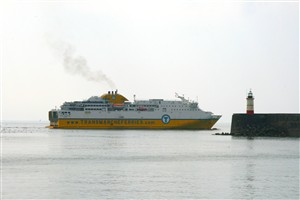
Cote d'Albatre leaves on the 50th anniversary of the start of the car ferry service. No flags, no fuss.
Rod Main
50th Anniversary, 1st June 2014
By Andy Gilbert
In the late 1950s and early 1960s, the Newhaven-Dieppe route was being run as a summer-only service between Easter and the end of October. It was operated by four fast passenger steamers (which were often referred to simply as the ‘mailboats’ as Newhaven-Dieppe held the contract to carry mail between the UK and France) that could all top 25 knots if required. Two of the steamers, Londres and Brighton (VI), sailed under the Red Ensign while the other two, Arromanches and Lisieux, bore the French Tricoleur. Londres and Arromanches were pre-WWII designs, and had entered service in 1947. The handsome Brighton dated from 1950 and the sleek Lisieux from 1953. The service also employed three rather slower cargo ships, Rennes, Brest and Nantes, affectionately known as the ‘Dieppe Screws’, and this trio was also French-flagged.
Continental car travel was very much on the rise and there had been a regular car ferry service from Dover to France and Belgium for some thirty years. However, if you wanted to travel abroad with your car from Newhaven, you had to arrive here early and your car was carefully craned on board one of the Dieppe screws. Looking at the swing of the car in its lifting cradle in the photo, you can imagine what might have been going through the mind of its owner! The cargo ship sailed for Dieppe some time before you did so you then spent a relaxing hour or so in Newhaven until it was time for your passenger steamer to leave. On arrival at Dieppe, if all had gone to plan, your car would have been craned off the cargo ship and would be sitting on the quayside waiting for you. It was clearly quite a rigmarole, but nevertheless the official figures show that nearly 40,000 motorists travelled between Newhaven and Dieppe with their cars this way in 1963!
The four passenger steamers had all been built in the days when the railway was still very important to the Newhaven-Dieppe service, and many sailings and arrivals were timed to connect with special ‘boat trains’ at both ports, offering a fast and direct link to London or Paris respectively. However, the numbers of boat train passengers were in serious decline and had been for some years. Overall passenger numbers for Newhaven-Dieppe had fallen by 29% from 1955 to 1962, compared to a rise of 34% on the short sea routes. In addition, the steamers were still two-class vessels, requiring many of the on-board services to be doubled up, with the obvious impact on running costs. If you added up all these factors, you might well think that the Newhaven-Dieppe route was in jeopardy back then. You’d be right, and press reports from the time show that closure had in fact been mooted on more than one occasion.
It was clear from the successful operations on the short sea routes and elsewhere that what Newhaven-Dieppe really needed was a proper roll on, roll off car ferry service. Interestingly, it seems that that particular term, later almost universally shortened to ‘ro-ro’, hadn’t yet appeared in the early 1960s - we were still talking about ‘drive on, drive off’ services in the advertising brochures and in the press back then.
However, it seems from local press cuttings that not everyone at Newhaven wanted the car ferry and all the extra traffic it would bring. Some felt that the route would be simply uneconomical, and one very prominent local politician described Newhaven as ‘shabby’ and ‘Victorian’, and stated he was certain that the town’s roads around the port entrance would not be able to cope, especially with the regular openings of the town’s swing bridge. (Looking at comments made these days about the route and the town’s traffic, it would seem that nothing much changes!)
When the decision to go ahead with the car ferry service was finally made, British Railways had to find a suitable ship for the route. A newbuild was out of the question due to time and cost constraints (we wouldn’t see a brand new British ship on the route until Senlac arrived in 1973) so they decided to convert two of their existing passenger steamers, Falaise and Normannia, into car ferries. The ship allocated to Newhaven was Falaise, built in 1946, though Normannia would be no stranger to the port in the years to come. At the time, Falaise was operating the Southampton to St Malo route, with weekly visits to the Channel Islands of Jersey and Guernsey and occasional stints on the Dover-Boulogne ‘Golden Arrow’ service. Falaise became available when the St Malo route was closed at the end of the 1963 season and on January 4th 1964 she was sent up to Vickers-Armstrongs’ Palmers Yard at Hebburn on Tyne for work to start on her conversion to a stern-loading car ferry. She arrived there on the 6th January and the work was completed in early May.
Both Falaise and Normannia were very smart ships as built, intended to be virtual ‘mini liners’, and they certainly looked the part. In fact, part of Falaise's regular duties involved running 'Short Sea Cruises' to places like Rouen and Le Havre and, on her debut in 1947, the Daily Echo described her as the Southern Railway’s 'biggest, most luxurious and newest ship’ and stated that 'She sets a new standard of comfort in cross-channel travel. Her amenities are comparable with those of a modern luxury liner'. Quite some praise! Well, there was certainly a lot of old-fashioned charm, comfortable seats and fine wood panelling in evidence inside her lounges. Inevitably, both ships lost some of their good looks as a result of conversion and certainly became more utilitarian inside but I think that, externally at least, Falaise coped with the surgery a little better than Normannia, with her higher bow giving her a more balanced appearance. (I can see some of my friends up at Dover shaking their heads in disagreement with that!)
At Newhaven, changes started to take place in readiness for the start of the car ferry service in the early summer of 1964. The new link span ramp was to be sited in what had traditionally been the ‘night berth’ for the passenger steamers up at the northern end of the East Quay, near the harbour offices and the Customs House. Construction work had started in 1963 and was planned to be completed well in time for the service to commence at the start of Summer 1964. Plans were also drawn up for a brand new car ferry terminal building to be built between the ramp and the town station but this would not be ready until sometime later. A large model of ‘Newhaven Harbour in 1965’ was constructed, complete with a slightly inaccurate model of Falaise (the model was made well before conversion work had been completed), showing the new ramp and the access roads it would need. This went on display at Newhaven’s Library in Church Hill some months before the opening of the route and attracted much interest.
Of course there was also to be a knock-on effect on the other ships on the route, one of which would immediately be surplus to requirements. Londres was withdrawn at the end of her 1963 season and towed away to Southampton by the tug Meeching just before Christmas. Her French-flagged sister Arromanches would follow her twelve months later at the end of the 1964 season. Both were to have new careers in Greek waters. Arromanches worked very successfully in the Mediterranean for many years, joined eventually by her Newhaven running mate Lisieux, but sadly Londres’ time would be cut short by a fire that gutted her a couple of years later.
Construction of the link span ramp continued apace and on 18th February 1964, Newhaven received a visit from the French car ferry Compiegne from the Dover-Calais service. She had paid a courtesy visit to Newhaven in 1959 to show off a little when she was brand new, but this time she turned through 180 degrees some distance off the breakwater and came in stern-first, as our car ferries would have to do for many years. Local press reports talk of her coming in alarmingly fast but nevertheless managing to stop comfortably short of the yet unfinished ramp. With basic berthing trials complete she sailed back to her usual route and it wasn’t until the 19th April that Normannia, fresh from her conversion work, became the first ship to actually use the brand new Newhaven link span. Interestingly, as can be seen in the photo of the nearly completed ramp, the night berth was still being used by the passenger steamers right up to the commencement of the car ferry service.
In May 1964, British Railways’ French partners in the route, SNCF, announced that they had placed an order for twin diesel powered car ferries for the route. These were to be named Villandry and Valencay and would be delivered in the summer of 1965. This announcement reflected the usual historic 2/3 to 1/3 French/British split on the route but, even so, there was still some press speculation at the time that only Villandry would be paired with Falaise and that the two remaining passenger steamers, Brighton and Lisieux would carry on alongside them, with two of the Dieppe screws also being retained. This speculation ended quite quickly when the three-ship car ferry service was officially confirmed.
Falaise made her maiden entrance into Newhaven just after 9.00am on 13th May 1964. Her arrival, although just three minutes behind schedule, apparently gave the West Pier staff a bit of a shock. She had been unable to make radio contact with the harbour control and thus appeared without warning out of a thick bank of fog that had blanketed the harbour. Her master, Captain G H Campbell, had very wisely decided to enter bow-first in view of the poor visibility and the fact that it was her very first arrival.
Falaise's conversion had lowered her gross tonnage from 3710 to 2416 and had given her space for just 100 cars, 75 on the main car deck and a further 25 on a mezzanine deck accessed by an internal folding ramp. Her freight capacity was tiny, just four lorries could be carried near the stern doors, and this was at the expense of some 20 cars. She was given a passenger certificate for 700 people, all in one class. The days of first and second class travel on the Newhaven route were finally over.
Falaise had been brought to Newhaven by a 'spare' crew drawn from other ships in the Railway fleet. The next couple of weeks gave her own Newhaven crews a chance to familiarise themselves with the workings of their new ship and this shake down period started the next day with the first berthing trials at Dieppe, where the car ferry ramp on the Quai Henri IV had just been completed. Trade vehicles were carried in both directions and further trips were made until the service was officially due to start.
So, on Sunday 31st May 1964, and with all the Railway ships in Newhaven dressed overall for the occasion, Falaise operated a special round trip for invited VIP guests only. There was a fair degree of ceremony that day, with Normandy dancers performing on the quayside. As Falaise sailed, she was escorted from the harbour by Meeching and I can remember being in a rather crowded wheelhouse on the tug that day. The following day, Monday 1st June, saw her officially inaugurate the Newhaven-Dieppe car ferry service, leaving at 10.00 am, and the first paying car to be loaded on board was, appropriately for a British ship, a Rolls-Royce! First day covers to mark the commencement of the service were printed on both sides of the channel.
Falaise had a few incidents during her first season (and would continue to do so over the years), hitting the pier at Dieppe within a couple of months and then again at Newhaven in October. Normannia was hastily pressed into service to cover for her on these occasions. After steering tests at sea by the British Ship Research Association, it was discovered that Falaise was unable to hold a proper course and rudder modifications were made to correct this. Despite these quite literal bumps along the way, Falaise managed to keep pretty much to schedule and offered a reliable service. Bad weather sometimes delayed her and, if things got too windy, she would have to enter the harbour bow-first and then rely on Meeching to turn her around. Meeching would often be needed again a couple of hours later to help pull Falaise’s bow off the berth for sailing. Bow thruster units wouldn't appear until the French twins arrived and even these two vessels needed help at times.
During her first season, Falaise was accompanied on the route by Brighton, Arromanches and Lisieux, plus the three Dieppe screws and, as you can see from the 'Full House' photo, the East Quay would often be chock-a-block with Railway ships. It wasn't only Brighton that made a lot of smoke as she fired up, Falaise would do the same and in those days she would sound a long blast on her whistle to announce her imminent departure, followed by a short blast as she left the berth. Nobody living nearby complained about either of these things back then, and you could almost set your watch by those whistle blasts! I heard them loud and clear from Southdown School every day.
It’s hard to overstate the importance to the route of this relatively small, and already 18 year old, converted ship, affectionately known by some as ‘Big F’. The impact Falaise had on Newhaven's traffic was instant and marked. In her first half year or so in service, she almost doubled the number of motorists using the route and increased the total number of passengers carried by over 12,000 despite the boat train figures dropping by more than 30,000. I think you could honestly say that Falaise single-handedly saved the route that year. When she was joined in the Summer of 1965 by Villandry and then Valencay, the route’s future as a car ferry service was secured and the two remaining passenger steamers were relegated to operating day trips and special excursions (away from Newhaven in Lisieux’s case) before they and the Dieppe screws were finally sold off. However, it wasn't until the end of the 1966 season that the last of the old ships, the Dieppe screw Brest, left the route. Apart from one year, when figures were badly affected by an SNCF strike, the next five years saw steady growth with almost half a million passengers being carried in 1970.
Falaise served the Newhaven-Dieppe route with the French twins until the end of her season on 25th September 1972. Her replacement, Senlac, arrived on the 5th March 1973, ushering in a new era, with the much larger ship offering more than double the capacity for cars and the ever more important freight traffic. After a short period working on the Dover-Calais run, Falaise was sent to Holyhead for further conversion work, involving the addition of new stern doors, and finally transferred back to the Channel Islands routes for which she was originally intended. She opened the new car ferry service from Weymouth to Jersey on June 1st, 9 years to the day after opening the Newhaven service. However, she was becoming increasingly unreliable and managed to run for only a season and a half before suffering serious boiler failures. She then came back ‘home’ to Newhaven for one last short lay-up period before being towed to Holyhead, where investigations showed she was beyond economical repair and she left for the breakers on Christmas Eve 1974. A sad and premature end to a ship that had made her mark by opening no less than three brand new services, in 1947, 1964 and 1973.
It’s ironic that as we mark the 50th anniversary of the opening of the car ferry service, the route’s future is once again in doubt, with current operators DFDS unwilling to continue running the services for Transmanche Ferries after 2015 under the conditions imposed by the route’s owners, the Conseil de Seine Maritime. There is also much discussion in France about the large subsidies being paid by the French taxpayers to keep the route alive. There are hundreds of jobs at stake on both sides of the channel and we can only hope that a satisfactory agreement can be reached next year.
It's also sad that, given this level of uncertainty, Transmanche Ferries decided not to mark the anniversary themselves. I hope that this page has given a flavour of what it was like when the carry ferry service commenced, and I'd also recommend a visit to Newhaven Museum, where a special exhibit has been created to mark the occasion.
Acknowledgements and thanks go to: Peter Bailey MBE and Tony Helyar at Newhaven Museum, Nigel Thornton at the Dover Ferry Photos Forum, Sussex Express, John Hendy and Miles Cowsill - “Newhaven Dieppe – the Car Ferry Era”, Kevin LeScelleur at www.channelislandsshipping.je, www.oldclassiccar.co.uk